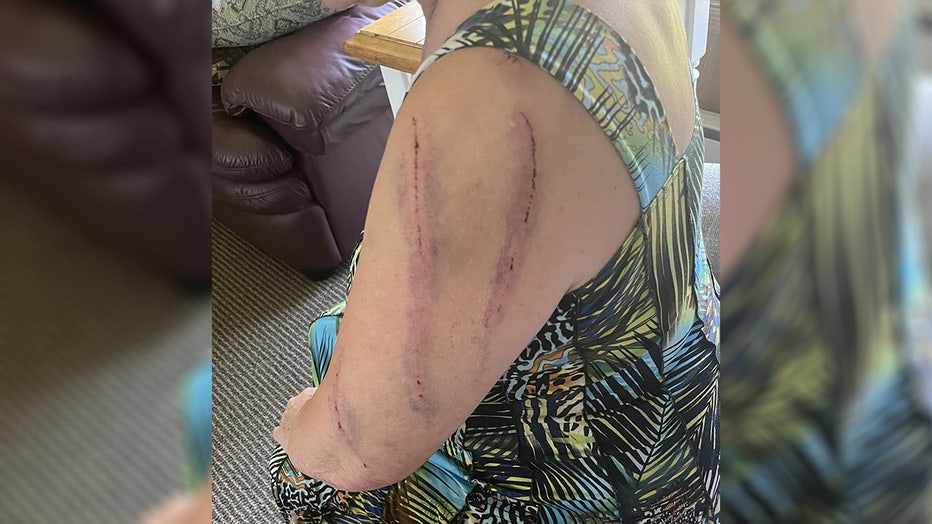Bear attack in central Minnesota: Sheriff's office releases photo of Minneapolis woman's injuries

Black bear "Honey" eats an apple in the black bear enclosure in the North American animal world "Manitoba" at Osnabrück Zoo. The animal originally comes from Malta, where it was rescued from poor husbandry conditions. Photo: Friso Gentsch/dpa (Photo (Getty Images)
NISSWA, Minn. (FOX 9) - A woman was hurt when she was attacked by a bear near Nisswa, Minnesota, last week.
The Cass County Sheriff's Office on Tuesday released a photo of the woman's injuries, including massive claw marks down her left arm.
The 65-year-old woman was attacked by a black bear on May 25 at a cabin in Fairview Township, which resulted in "injury and medical treatment," the sheriff's office said. She had let her dog outside around midnight when she heard the dog having a confrontation with something. She went outside to bring the dog in and she encountered the bear.
"She was struck by the bear in the chest and arm, and knocked to the ground," the sheriff's office said.
The woman's family members heard the struggle and scared the bear away from the victim and yard. She was taken to the hospital in Brainerd and received treatment for injuries to her shoulder, chest and back.

A 65-year-old Minneapolis woman was attacked by a bear on May 26, 2023, in Fairview Township, Minnesota, located in near Nisswa. (Cass County Sheriff's Office)
The Minnesota DNR's wildlife staff believe the bear was likely startled by the encounter and swatted at the woman to defend itself. The bear immediately left the area after the incident.
"Bears that feel comfortable living near people may become more unpredictable when faced with a stressful situation, such as a dog showing up unexpectedly," the DNR said in a statement Saturday afternoon. "Each year in North America, there are thousands of interactions between people and black bears without incident."
The DNR said the bear attack on Friday was the 10th incident involving a serious injury since 1987. Black bears are rarely aggressive and attacks on people are uncommon.
To avoid attracting bears, the DNR recommends removing sources of foods such as bird feeders, feeding pets indoors, storing trash in bear-proof containers, and keeping barbeque grills clean.
The DNR said conservation officers are monitoring the area for bears that may pose a threat to public safety.
Here are tips from the sheriff's office and DNR to stay safe around black bears:
- Watch from a safe distance or from inside to assess why it is there (for example, is there a food source like birdseed attracting it?).
- Wait and see if the bear leaves on its own. If the bear does not leave on its own but approaches (e.g., comes up on the deck or puts its paws on windows or doors), it’s time to try to scare it away: boldly shout, bang pots, slam doors, or throw something.
- Try to appear non-threatening.
- Speak to the bear in a calm tone and slowly back away. Do not run.
- If you have bear spray, remove the safety, and point it toward the bear. Starting with a quick spray is OK, as that will not make the bear aggressive. Bear spray containing capsaicin (hot pepper liquid) is a good option to change the behavior of bold bears. It also gives you peace of mind and can prevent a bear from attacking. It is available at most outdoor stores or online sporting goods retailers.
- If the bear retreats, leave the area immediately.
"Sometimes bears exhibit a quick burst of aggression to defend against a perceived threat. The closer you are to the bear when it becomes aware of your presence, the more likely it is to exhibit defensive behavior," the sheriff's office said. "This behavior is intended to intimidate and scare away the threat. It may pop its jaws, swat at the ground while blowing or snorting, and it may even bluff charge toward you. The bear is communicating to you that you are too close and it wants you to leave. This is not the time to argue with the bear."

